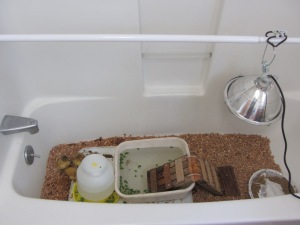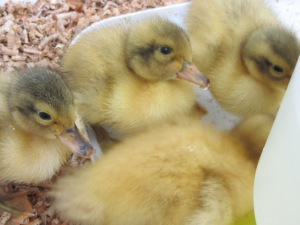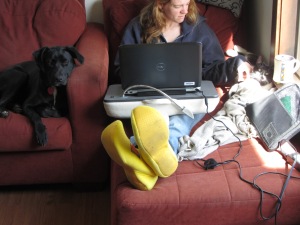The garm now officially has livestock: yesterday we purchased four little female Welsh Harlequin ducklings. Welsh Harlequins are known for their excellent egg production, strong foraging abilities, and friendliness toward people, so we have high hopes for them. Despite my concerns over the fate of “excess” male ducklings produced by hatcheries, we bought sexed females only, because we decided that the prospect of getting a larger number of unsexed ducklings and likely having to slaughter several males only a few months later was too much for us to handle at this point in our garming lives. We also decided that, since egg-laying breeds like Harlequins have mostly lost their brooding/mothering (if not mating) instincts, and we have no immediate plans to breed them anyway, there was no good reason for us to get a drake right now. We’re taking this adventure one step at a time.
For now, I’ve made the tub in our guest bathroom into a brooder, taping over the drain and putting down a layer of wood shavings, then lowering the shower curtain rod and suspending a heat lamp from it.

The bathtub brooder
Water for the ducklings is provided in a cheap, automatically refilling circular trough – basically just a plastic jug turned upside down and screwed onto a lid with a little moat around it. This set-up solves two problems at once: (1) it ensures they never run out of water, which ducklings need a lot of; (2) ie makes it harder for them to step in (and defecate in) their own water, which they still somehow manage to do but would presumably otherwise be doing with much greater frequency.
Their food is an organic poultry starter crumble, which I bought at our local co-op to ensure they have proper nutrition at this early stage. I’ve also supplied a little clean sand as grit for their crops. And they’re getting plenty of leafy greens, torn up into tiny pieces and floated in their water to keep fresh, as well as periodic deliveries of live isopods (sowbugs) and the occasional small slug or earwig. They are figuring out how to eat these more natural foods, which is all part of the plan – when they reach adulthood (in only two short months or so), they will be foraging for most of their own food, and helping to reduce my garden pest population in the process. (Turning slugs, snails, and other pests into delicious eggs, with minimal purchased food and other external inputs, is the grand design here, and the reason we decided to get ducks to begin with.)

Ducklings gathered at the waterer
Finally, they currently have access to a tub of water for swimming, complete with ramps to allow them to easily enter and exit. I’m providing the swimming water because I’ve read that allowing ducklings to swim in their first few days stimulates their waterproofing oil glands, which otherwise do not become active until nearly adulthood. And the ramps are there because I’ve also read that chill and drowning are primary causes of mortality among ducklings, typically resulting from an inability to get out of the water when they need to.
I have now placed the ducklings in the water several times. Each time, they panic for the first second or two, then settle in and begin happily paddling around and nibbling at the leaf scraps I’ve provided. The second time I put them in, they discovered that they could go under the water, too, and seemed to delight in repeatedly half-diving and submerging their little heads and bodies.
Before I left them alone with the swimming water, I made sure that all of them knew how to get out of the tub and safely back to the dry wood shavings under the heat lamp. They figured that part out fairly quickly. As far as I can tell, however, they have yet to turn back around, climb the ramp, and re-enter the water of their own volition. I’m not sure if that’s because they haven’t figured out that they can do that, or because they don’t really want to swim, despite their apparent enjoyment of the activity.

Swimming in the tub

Eating & swimming
They’ll probably be in the bathtub brooder for three or four weeks, at which point they’ll have grown too big for it and will have to be moved to either a makeshift pen in the garage or to the old chicken house which I cleaned up and prepared as part of their future adult nighttime quarters. In the meantime, we’re enjoying their company in the house – and keeping the bathroom door closed and latched so the dog and cat have no opportunity to meet them.









